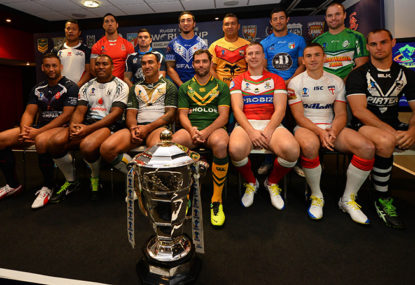Nothing ButWT
new author
Roar Rookie

Much has been said about the Rugby League World Cup and its legitimacy. In fact you could say that too much has been said.
After Australia defeated the USA 62-0 in the RLWC, an article was published slating the tournament and, unsurprisingly slating the sport itself.
According to the author, the RLWC has no fans, no support and the players involved use the event for no reason other than to take a holiday.
Little research was conducted and used in the original article.
The crowd size at the Australia versus USA game was highlighted in the article, coincidentally it was the only crowd figure mentioned.
In the 25 games so far, 316,490 people have attended games at an average of 12,660.
The last World Cup (2000) to be held in the UK saw 263,921 people attend the 31 games played at an average crowd of 8,514.
Once again, not only are the games being played in front of good crowds, the World Cup and rugby league as a whole has increased in popularity in the UK, contrary to some media reports.
It has also been well documented that 7mate is not available to everyone in Australia who wants to watch the World Cup.
It has also been written that the RLWC has attracted zero interest in Australia. I would love to know what facts journalists used for these statements.
So far, 1.96 million Australians have tuned in to the World Cup coverage on Channel Seven at an average of 76,800 per game.
Rather impressive considering only three of the teams competing “are any good at the sport”.
Something that hasn’t been documented for one reason or another, is the road in which RLWC debutants Italy and the USA took to get to the World Cup.
In 2011, Italy qualified for the tournament after winning the European qualifying group. The United States also qualified for the tournament after finishing atop the Atlantic qualifying group.
They won their spot at the World Cup, they are not ‘token’ sides.
Just because these facts aren’t documented in day to day newspapers does not mean they don’t exist.
Journalists speak about international rugby league like there are only three countries who play the sport and have a national team recognised by the international governing body.
Once again, facts show that there are currently 29, yes 29 countries who are officially ranked by the RLIF (Rugby League International Federation) and a further nine countries who at this time have not met the criteria to be a ranked nation.
I am sure the members of these 29 teams, most of which pay their own way to tournaments and don’t get paid for making the side, just like to use international rugby league as an excuse for a holiday.
It has also been expressed that players see the tournament and international rugby league as a joke.
I have seen zero quotes obtained to back this up. At the start of the World Cup, the Wests Tigers website had an interview with Marika Koroibete after he made his Test debut for Fiji.
The quotes in the interview show what this “joke” of a World Cup means to players, whether they are from a ‘powerhouse’ nation or a ‘minnow’.
“It was a dream come true”
“I’m really proud to play for my country”
“It’s been great playing for my country, in front of my family and trying to make them proud”
These were some of the quotes from Marika Koroibete in his interview with Wests Tigers.
But those quotes aren’t the only evidence of what the World Cup means to players.
Vision of players from France, Fiji and other nations shedding a tear during the national anthem and the passion shown in the island nation’s war dances and hymns.
It’s funny, during the NRL season, fans’ expectations of players are that they will “try their best and put in 100% effort”, but put a rep jersey on the same players and the expectation changes to “they put 100% effort in, tried their hardest, but I’m not watching because they aren’t very good”.
If you need any further evidence of what the World Cup is really about and what it means to those who take part, take a look at the photos on Twitter of players from opposing countries linking arm in arm at the end of a game to say a prayer, after bashing each other for 80 minutes.
Do I like seeing teams get beaten by 50 plus points every game? No, but a melodramatic reaction to a result in a game between a nine-time World Cup winner against a nation making their debut in the tournament is ludicrous.
Do the same theories apply now in the NRL? Where three teams conceded the same amount of points as the USA (62) or more in 2013?
Did rugby league die out when St. George won 11 competitions straight? Was Canterbury kicked out when they lost 91-6 to the Dragons? Or how about when the Sharks lost 74-4 to the Eels? Knee-jerk reactions do little to help restore pride in a sport that has taken countless blows from media in 2013.
Oh and by the way, every nation at the World Cup donated a fully signed team jersey to raise funds for the victims of the NSW Bushfires. It’s just another piece of positive news in rugby league which has gone unnoticed and unpublished.
Respect rugby league for what it is and what it always has been.